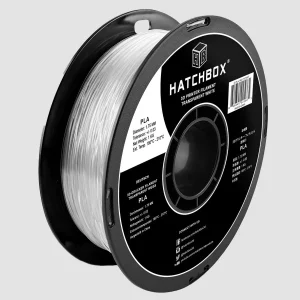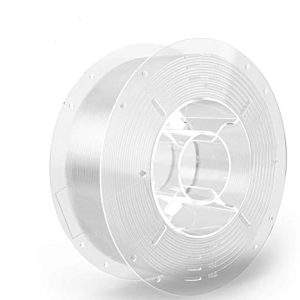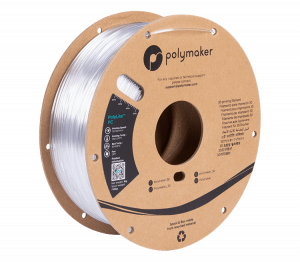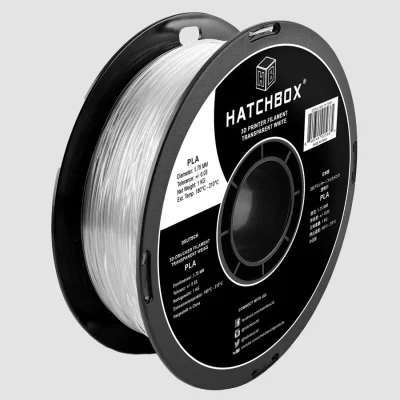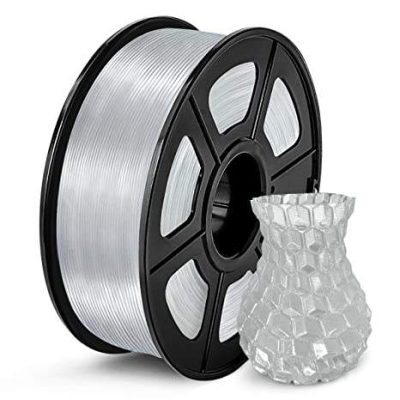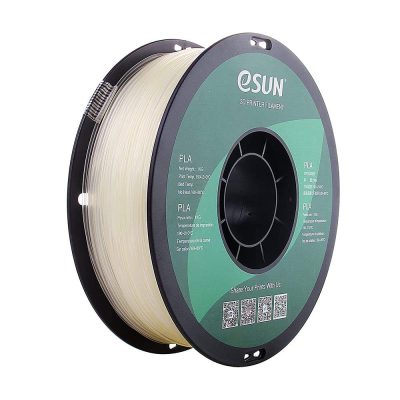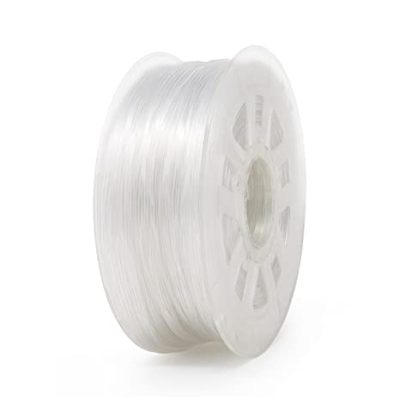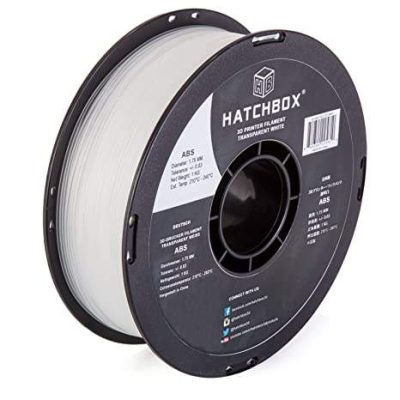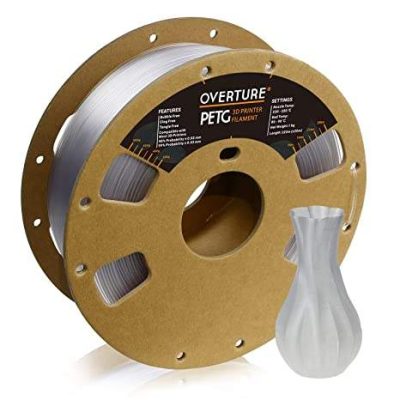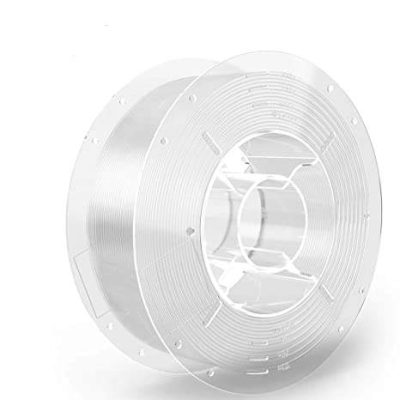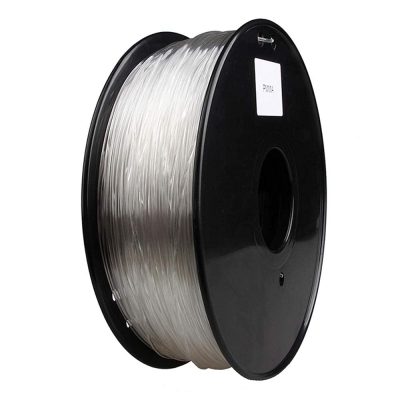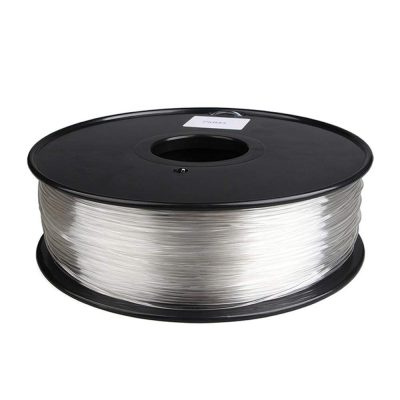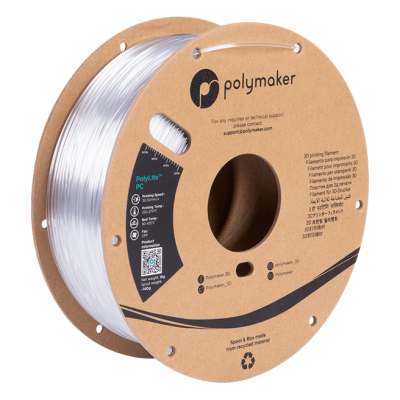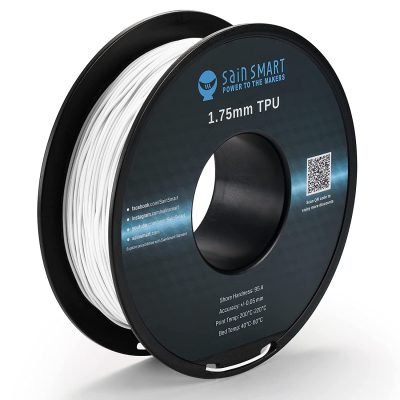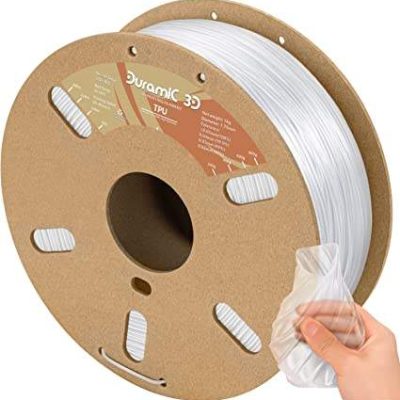- Last Updated: January 12, 2024
-
 Pat Nathaniel
Pat Nathaniel
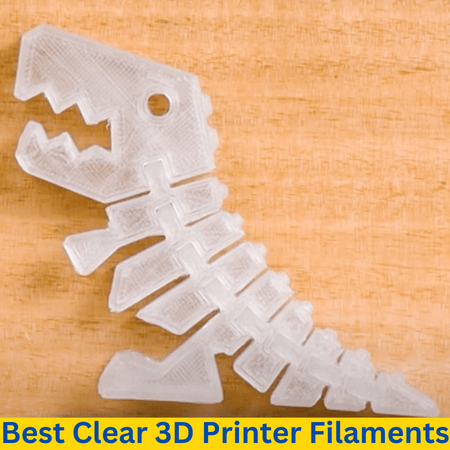 Print parts that have nothing to hide. Clear filaments let you create truly unique-looking prints.
Print parts that have nothing to hide. Clear filaments let you create truly unique-looking prints.
You can print clear parts from the same materials you’re used to — or go for something completely different. With a wide range of material options, there’s a transparent filament for every application.
But you must choose carefully. Different filaments have varying properties and produce more or less clear results. Don’t waste your money on a filament that won’t come out as transparent as you’d like.
Our favorite clear transparent 3D printer filament are:
- Hatchbox PLA and ABS are your go-to filaments for transparent color prints.
- MSNJ Clear PMMA offers extremely clear transparency.
- SainSmart PRO-3 and Polymaker PolyLite PC print strong parts.
- Duramic Clear TPU lets you dip your toes into printing flexible parts.
Read on to learn what is the best clear 3D printer filament for you!
Top 12 Clear 3D Printing Filaments in 2022
PLA Filaments:
1. Hatchbox Transparent PLA
2. Sunlu Clear PLA
3. eSun Clear PLA
ABS Filaments:
4. Gizmo Dorks ABS
5. Hatchbox ABS
PETG Filaments:
6. Overture Transparent PETG
7. SainSmart PRO-3
PMMA Filaments:
8. QDTD Clear PMMA
9. MSNJ Clear PMMA
Polycarbonate Filament:
10. Polymaker PolyLite PC
TPU Filaments:
11. SainSmar Clear TPU
12. Duramic Clear TPU
PLA Filaments
Nozzle Temperature: 356-428°F (180-220°C) | Bed Temperature: Not required | Spool Size: 1kg | Diameter: 1.75mm | Color: White, black, red, blue, yellow
Who said your clear 3D prints can’t be colorful? Certainly not Hatchbox.
These transparent, colored filaments let you introduce a spot of color to your clear prints.
Hatchbox’s clear PLA filaments have medium transparency and are available in five different colors. The color options make them a great choice for printing, for example, light covers or Christmas ornaments.
You can print those parts with little effort, too. These filaments work with low nozzle temperatures and don’t require a heated print bed, which makes them easily printable with any printer. With tight dimensional accuracy, you can expect good, consistent quality.
But the filaments are very brittle. You have to handle them carefully to avoid breakage and should dry them thoroughly before printing.
Pros
- Many color options
- Easy to print
- Good print quality and strength
Cons
- Very brittle filament
- Needs drying
Nozzle Temperature: 374-428°F (190-220°C) | Bed Temperature: 77-140°F (25-60°C) | Spool Size: 1kg | Diameter: 1.75mm | Color: Clear
Sunlu is famous for its wide range of PLA filaments, which also includes a clear option. With this clear PLA filament, you can print good-looking parts quickly and easily.
The filament does its job like a professional — efficiently and without grumbling. It comes out of the nozzle effortlessly with little stringing or layer separation. If it’s a consistently nice print quality you’re after, here’s the material for you.
And the filament is strong to boot.
The prints come out so sturdy that you might need pliers to break off supports. You won’t have to worry about accidentally breaking your prints.
You should note, though, that the prints come out only as translucent — not transparent. Small objects can be almost glass-like, but the larger your print, the more opaque it’ll be. The finished prints can also have a very faint yellow tinge.
Pros
- Easy printing
- Strong parts
- High print quality
Cons
- Only semi-transparent
- Prone to yellowing
Nozzle Temperature: 374-446°F (190-230°C) | Bed Temperature: 45-60°C | Spool Size: 1kg | Diameter: 1.75mm | Color: Clear
Cheap quality is one of those things that just doesn’t exist — unless you’re talking about eSun’s Clear PLA filament. This translucent PLA offers great value for its price.
Now, eSun’s Clear PLA isn’t the cheapest filament you can buy (although it’s definitely affordable). But the quality you get from it is worth every penny.
This translucent PLA filament produces prints with a very nice level of detail. It’s more challenging to print than Hatchbox or Sunlu PLAs, so be prepared to experiment with your settings to avoid jamming issues. But once you’re all dialed in, you’ll be churning out reliably good-looking prints.
Like Hatchbox, eSun’s filament doesn’t produce completely transparent results. Big prints in particular can come out cloudy. But use it for the right parts and eSun will look great.
Pros
- Good value
- Excellent print quality
Cons
- Prone to jamming
- Cloudy transparency
ABS Filaments
Nozzle Temperature: 446-482°F (230-250°C) | Bed Temperature: 230°F (110°C) | Spool Size: 1kg | Diameter: 1.75mm, 2.85mm | Color: Transparent
Want to print clear parts on a budget? Then you need the transparent ABS filament from Gizmo Dorks. These dorks have created a filament with nice translucency and a very low price.
You might think cheap filament doesn’t give good results. But don’t let that price fool you. This ABS filament produces good-looking parts with strong layer adhesion.
As an ABS filament, it’s also compatible with most 3D printers with enclosures. It’s a good choice if you want good quality and pretty translucency without spending a lot of money.
You should be prepared to work for your prints, though. Without precisely tuned print settings, this filament tends to warp and detach from the print bed. It is ABS, after all.
If you don’t mind the challenge, though, Gizmo Dorks is a great budget option.
Pros
- Affordable
- Good-looking prints
Cons
- Difficult to print
Nozzle Temperature: 410-464°F (210-240°C) | Bed Temperature: 131-185°F (55-85°C) | Spool Size: 1kg | Diameter: 1.75mm | Color: White, black, red, blue, green, yellow, orange
Hatchbox makes more than just clear PLA filament — it also offers clear ABS filament. And what filament it is!
If you want prints with gorgeous transparency in many colors, look no further.
Hatchbox ABS gets closer to true transparency than many others on this list. With the right settings, you can get very clear parts that let light brightly shine through them.
This filament is relatively quick and easy to print for ABS, but it is brittle. Still, you can start making nice-looking prints without spending as much time tweaking your printer settings.
And then there’s the color.
Hatchbox’s transparent ABS filaments are available in even more colors than their PLA range. These filaments are your choice if beauty in color is your priority.
Pros
- Excellent transparency
- Many color options
Cons
- Challenging to print
- Brittle filament
PETG Filaments
Nozzle Temperature: 446-482°F (230-250°C) | Bed Temperature: 176-194°F (80-90°C) | Spool Size: 1.5kg | Diameter: 1.75mm | Color: Clear, blue, green, red
Overture clear PETG filament is a real jack of all trades. This material does a bit of everything at a low cost.
This filament is easy to print with the right settings. PETG can be pretty unforgiving, so you’ll have to tune your settings accurately. But once you’ve done that, it makes for consistently excellent and durable parts.
You shouldn’t eat off of it, but PETG is food-safe so you can print, for example, aquarium decorations. Overture offers three color options, so you can print impressively transparent decor in your fish’s favorite color.
And the price is right with this filament. As a downside, although the cardboard spool is eco-friendly, it can have some rolling issues.
Pros
- Good transparency
- Color options
- Affordable
Cons
- Needs precise settings
- Cardboard spool
Nozzle Temperature: 428-482°F (220-250°C) | Bed Temperature: 0-122°F (0-50°C) | Spool Size: 1kg | Diameter: 1.75mm | Color: Clear
It’s clear, it’s easy, it’s durable. That’s SainSmart PRO-3 clear PETG for you. This filament is what you need for clear parts that withstand impacts.
SainSmart promises no jamming and, for once, that’s not just a marketing spiel. PRO-3 is remarkably easy to print for PETG. With next to no warping and impressive dimensional tolerance, you can print without worries.
But the best thing about PRO-3 is its durability.
This is a fairly flexible filament that bounces back to its original form after impact. It’s great for parts that you’ll handle regularly. If you’ve ever dreamed of translucent screws or nuts, don’t say “nuts” to PRO-3.
PRO-3 costs more than Overture’s PETG. But you get your money’s worth in quality.
Pros
- Excellent durability
- Simple printing
Cons
- A bit pricey
- No color options
PMMA Filaments
Nozzle Temperature: 392-464°F (200-240°C) | Bed Temperature: 212-248°F (100-120°C) | Spool Size: 1kg | Diameter: 1.75mm | Color: Clear
QDTD isn’t exactly a household filament brand, and PMMA isn’t a common print material. But don’t let the obscurity scare you away. QDTD’s clear PMMA filament has excellent transparency.
How transparent is it, you ask?
The material is recommended for printing things like lampshades or stained “glass,” or to straight-up replace glass on mobile phone screens. That should tell you all you need. With this filament, you can produce extremely clear prints.
If your printer can handle it, that is.
There’s a reason why PMMA isn’t a commonly used filament — it’s difficult to print. QDTD PMMA requires a seriously hot printing bed or it will warp hopelessly. It’s also very expensive.
But if you need glass-like transparency, money isn’t an issue, and you’re a skilled printer operator, give QDTD a go.
Pros
- Transparent like glass
Cons
- Very challenging to print
- Expensive
NozzleTemperature: 392-464°F (200-240°C) | Bed Temperature: 212-248°F (100-120°C) | Spool Size: 1kg | Diameter: 1.75mm | Color: Clear
Maybe you’ve heard of this unusual transparent PMMA filament and want to give it a try, but that high price point looks scary. MSNJ can help you. This company’s filament is relatively affordable for PMMA.
In transparency, MSNJ sits right there at the top with QDTD. After all, it’s PMMA.
If it’s beautifully glassy end results you’re after, MSNJ will deliver. Its price point is also significantly lower than QDTD’s, although the filament is still quite expensive. You’ll also get less material on the spool.
As a PMMA product, MSNJ will be difficult to print. Although the manufacturer claims it’s easier to handle than comparable filaments, you’ll still need a printer capable of high temperatures.
That said, MSNJ offers a less costly stepping stone into printing clear lenses, car parts, and more.
Pros
- Great transparency
- Relatively affordable
Cons
- Still expensive
- Difficult to print
Polycarbonate Filaments
Nozzle Temperature: 482-518°F (250-270°C) | Bed Temperature: 194-221°F (90-105°C) | Spool Size: 1kg, 3kg | Diameter: 1.75mm, 2.85mm | Color: Clear
PolyMaker’s PolyLite transparent polycarbonate (PC) filament is a solid material — in every sense of the word. It makes for parts that are as strong as a hardcore gym bro.
And strength really is the name of the game here.
PolyLite parts resist pretty much anything. Impacts, bending, heat… Your parts can take it all and still be ready for more punishment.
They won’t look bad, either. PC produces a glossy surface that looks almost crystalline. For clearer results, just crank up the nozzle temperature.
If you can.
PC is a demanding material that requires extreme printing temperatures. It can also easily clog your nozzle or detach from the bed, so it’s not for beginners. This is also an expensive filament.
That strength is worth the effort and money, though.
Make sure to check out our article on the best polycarbonate 3D printers to learn more.
Pros
- Very strong prints
- Heat resistance
- Good print quality
Cons
- Needs a high-temperature printer
- Prone to print errors
- Expensive
TPU Filaments
Nozzle Temperature: 383-446°F (195-230°C) | Bed Temperature: 104-140°F (40-60°C) | Spool Size: 1kg | Diameter: 1.75mm | Color: Clear
It bends, it stretches, and it bounces right back! It’s not some children’s stretchy toy, though. It’s just a print made with SainSmart clear TPU filament.
This is your material if strong and flexible clear parts are your thing.
SainSmart’s transparent TPU produces prints that are malleable but have enough strength to not rip and tear. Rubber ducks or phone covers, this stuff will get it done.
TPU is also naturally clear, so you’ll get nicely transparent parts.
But be warned, this filament is a challenge to print. It’s prone to stringing and you really should have a direct drive extruder to avoid constant clogging. That’s not a SainSmart problem, mind you — it’s just how TPU works.
Give it a chance, though, and SainSmart gets you bendy, clear prints.
Pros
- Strong and flexible parts
- Nice translucency
Cons
- A bit pricey
- TPU is difficult to print
Nozzle Temperature: 410-446°F (210-230°C) |Bed Temperature: 77-140°F (25-60°C) | Spool Size: 1kg | Diameter: 1.75mm | Color: Clear
Want to try printing transparent TPU filament without breaking the budget if it ends up being your thing? Here comes Duramic clear TPU.
This filament is an excellent wallet-friendly stepping stone into TPU 3D printing.
Duramic TPU is more affordable than many others, like SainSmart. But that doesn’t mean you’ll compromise quality.
Your prints will be very stretchy and rubbery. You’ll get a good idea of what TPU is about at a low cost.
The filament comes in a cardboard spool, which is a bit of an issue. It’s better for the environment, sure, but flexible filament tends to stick to the spool.
TPU is hard to print and needs a direct drive nozzle. It’s a good thing the filament is cheap because beginners in particular may mess up the first couple of prints.
Check out our article on the best 3D printers for flexible filament here.
Pros
- Very bendy and stretchy
- Affordable TPU filament
Cons
- Challenging to print
- Filament sticks to cardboard spool
Clear 3D Printer Filaments — The What and How
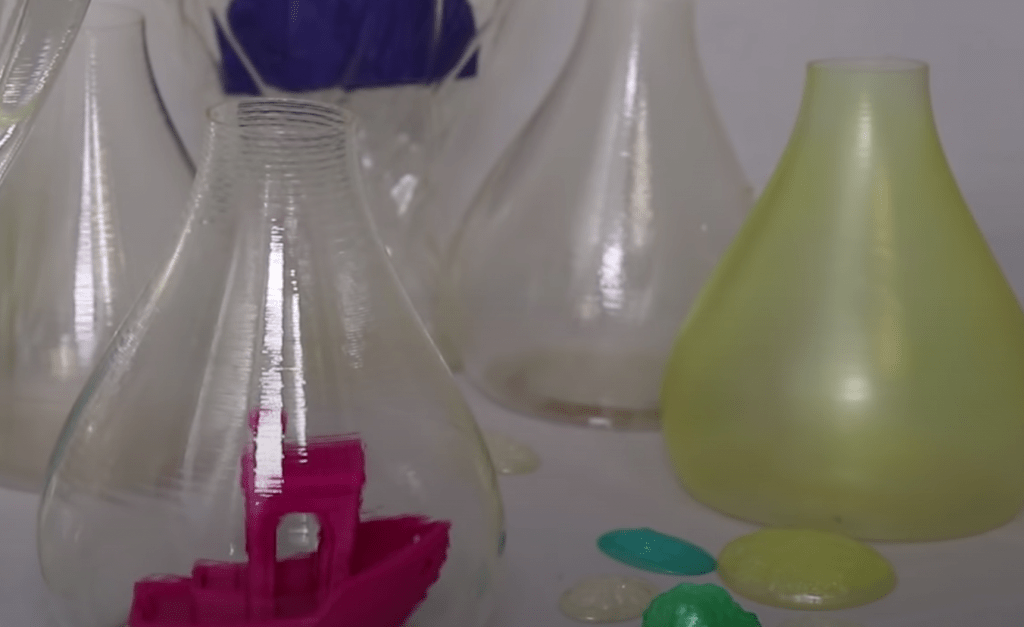
Think you’re a real 3D printing guru? Then put your skills to the test by giving clear 3D printing filaments a try.
Printing with clear filament can be an exciting challenge. Do it right, and you’ll get stunning translucent objects. There are also many options for materials so you can most likely use whatever filament you’re used to.
But transparent filaments can be tricky to work with. You need to tune your 3D printing settings carefully to get proper transparency. Otherwise, you’ll end up with cloudy or milky prints.
Let’s take a closer look at clear filament, how you can successfully print it, and what you should use it for.
What is Clear 3D Printer Filament?
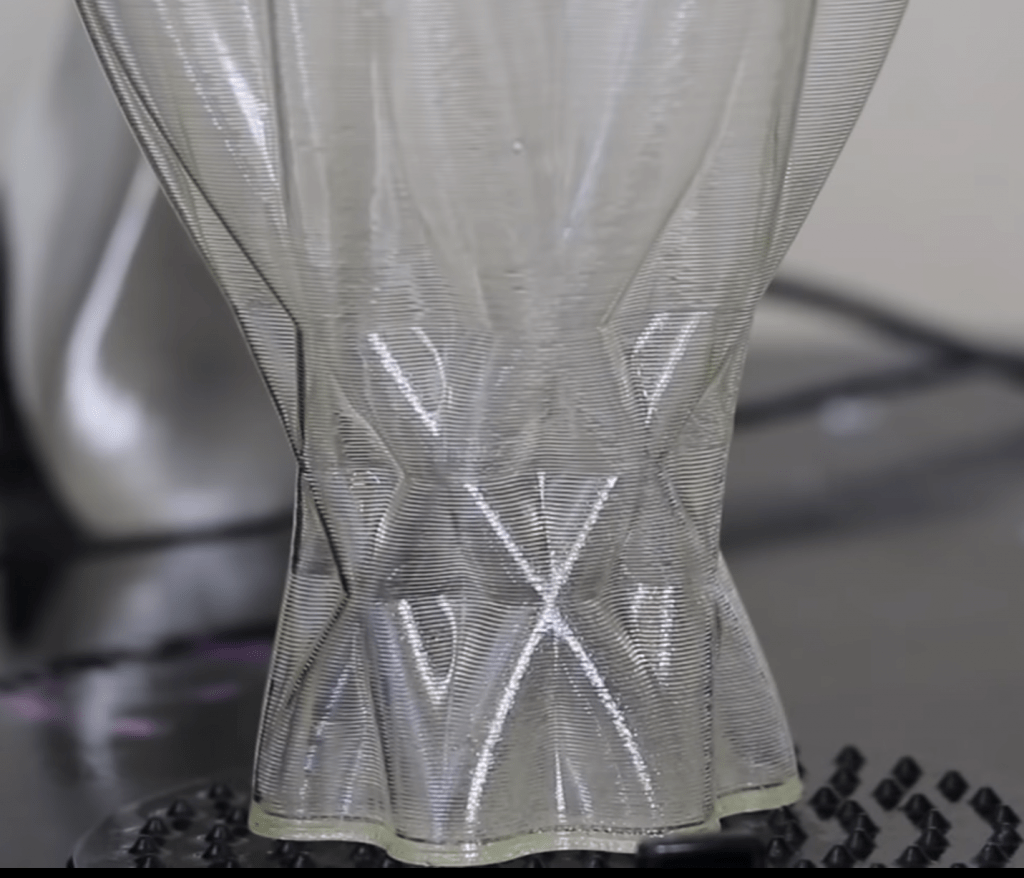
Clear filament is simply FDM 3D printing filament that lacks color. And I don’t mean that it’s white — it’s transparent to varying degrees. That said, you can also get dyed transparent filament that’s still see-through.
It might sound like an exotic material. But many 3D printing filaments, like PETG or nylon, are naturally transparent.
Manufacturers have to process to get them to stop being clear.
Other materials, such as translucent PLA or ABS, aren’t clear by nature. To get them to become transparent filaments, manufacturers use chemicals or other treatment processes.
This also points to one big distinction between the types of clear filament. The materials that are naturally clear often produce more transparent results. Treated filaments, on the other hand, are usually cloudier and can yellow with age.
But whichever kind you use, as long as you print it right, you can get good-looking results.
How to Successfully 3D Print Clear Filaments?
It’s impossible to give recommendations for printer settings that will work with all clear filament materials. That said, there are certain universal guidelines for printing with clear filament.
These tips can help you print gorgeous, transparent objects.
Use a High Hot End Temperature
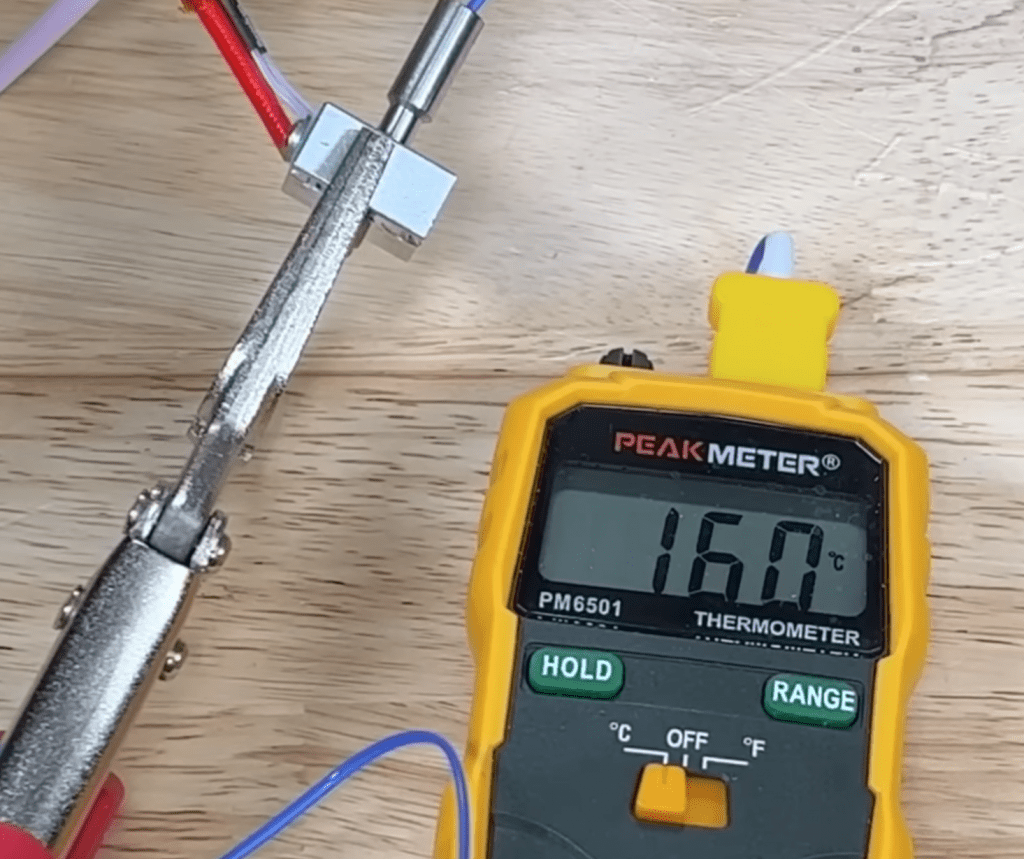
You want your layers to fuse together as perfectly as possible to reach maximum transparency. Try printing at the highest temperature your filament can take (unless you work with TPU). You’ll minimize internal refraction and get clearer parts.
Increase Layer Height

You can also decrease internal refraction by increasing layer height. The more layers light has to go through, the more it scatters and the less clear your part looks. You’ll lose some surface detail, but the transparency may make up for it.
Print with Low Infill (or 100% Infill)
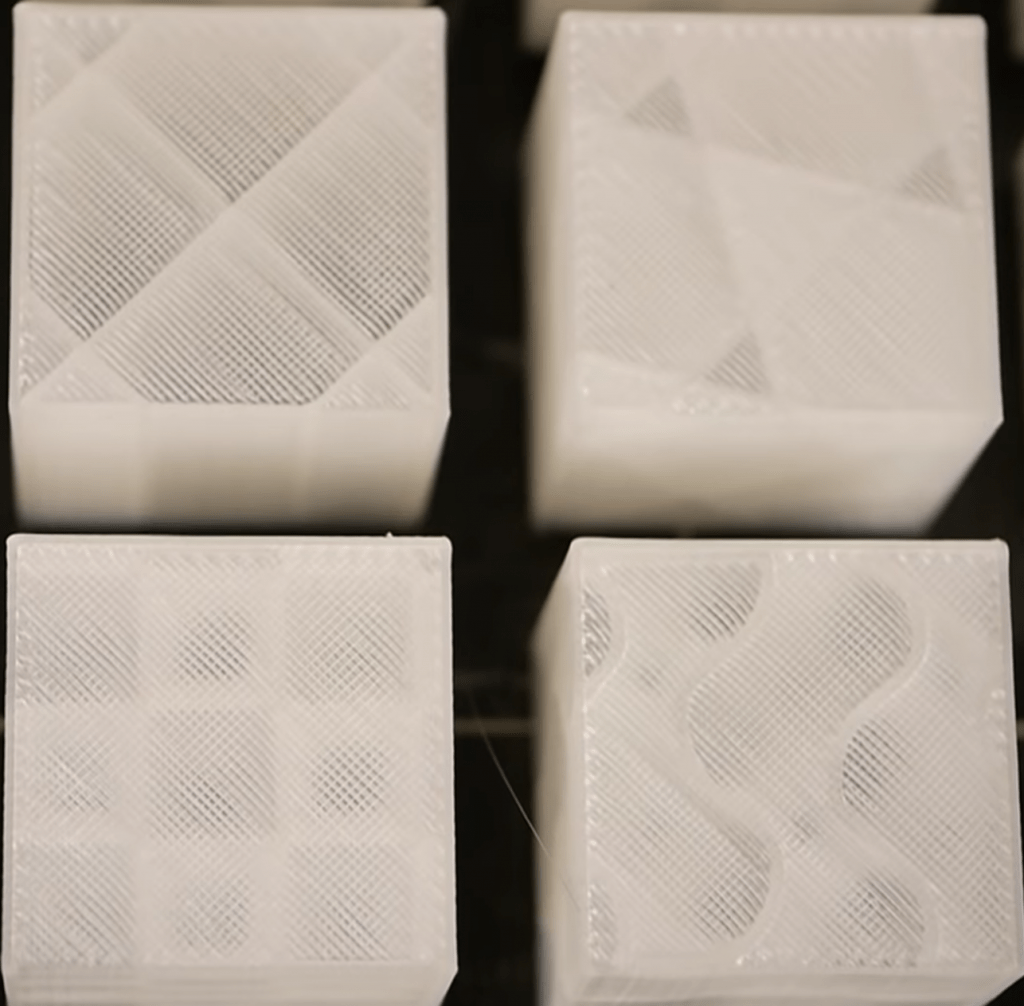
Use the lowest possible infill to remove as many plastic-to-air transitions within your print as possible. Alternatively, you can try 100% infill, though such a thick blob of plastic may block light and cause printing issues.
Make Thin Walls
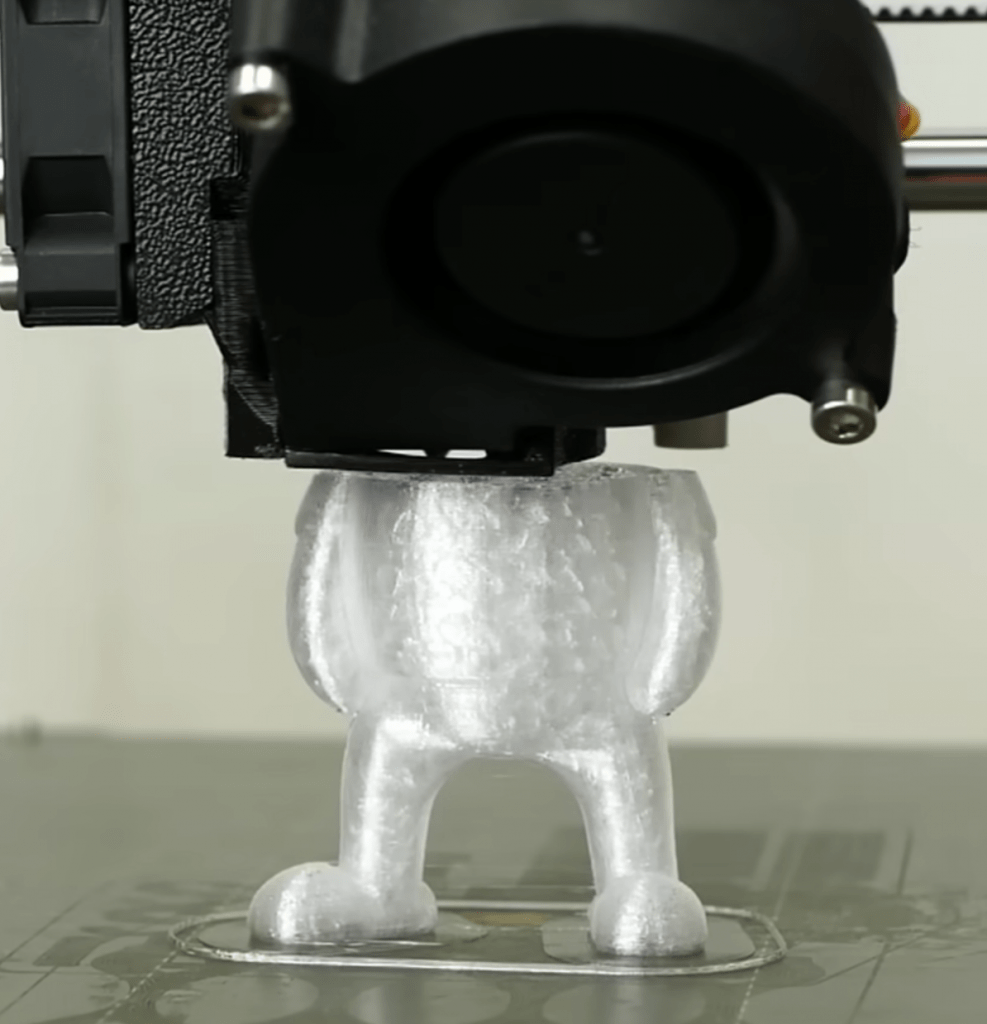
Thinner walls block less light and make prints look more transparent. Make your walls as thin as your material allows while still maintaining printability.
Post-Process Your Prints
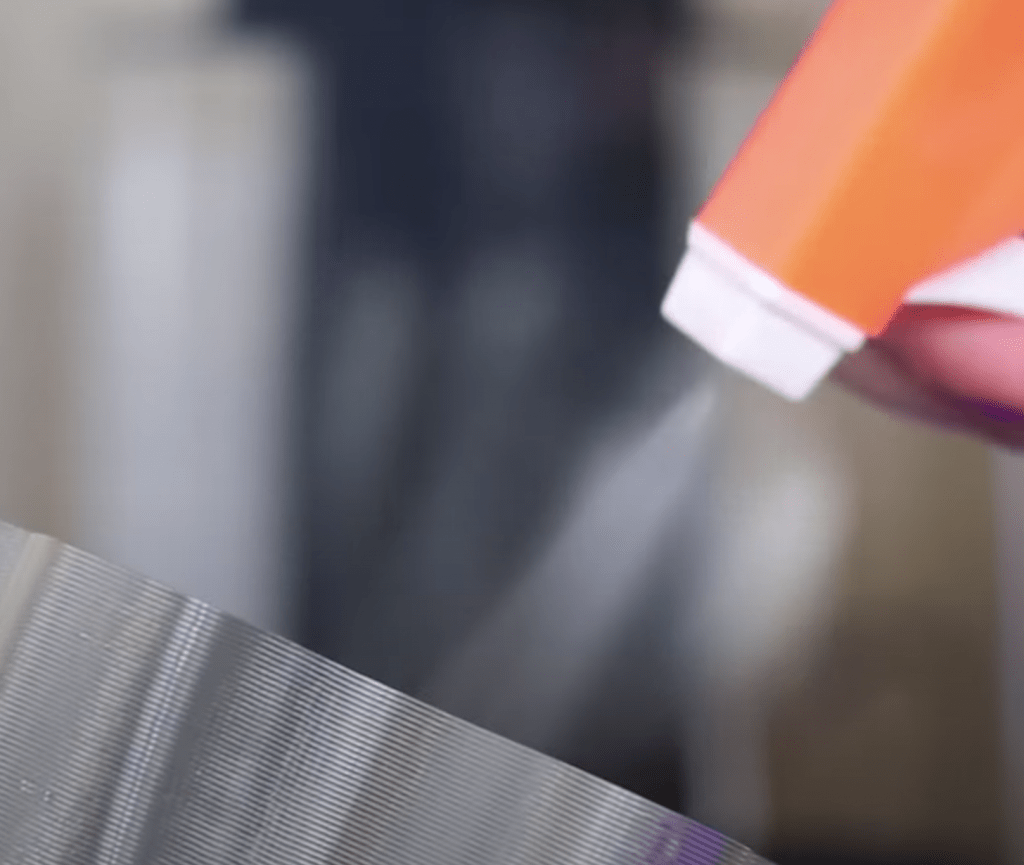
No material is perfectly clear without post-processing. Some filaments you can simply sand and polish, but others need vapor treatment with chemicals, like acetone. Every material isn’t suitable for all post-processing methods, so do some research on your filament and also check out our article on how to smooth 3D prints.
Ideal Uses for Clear 3D Printer Filament
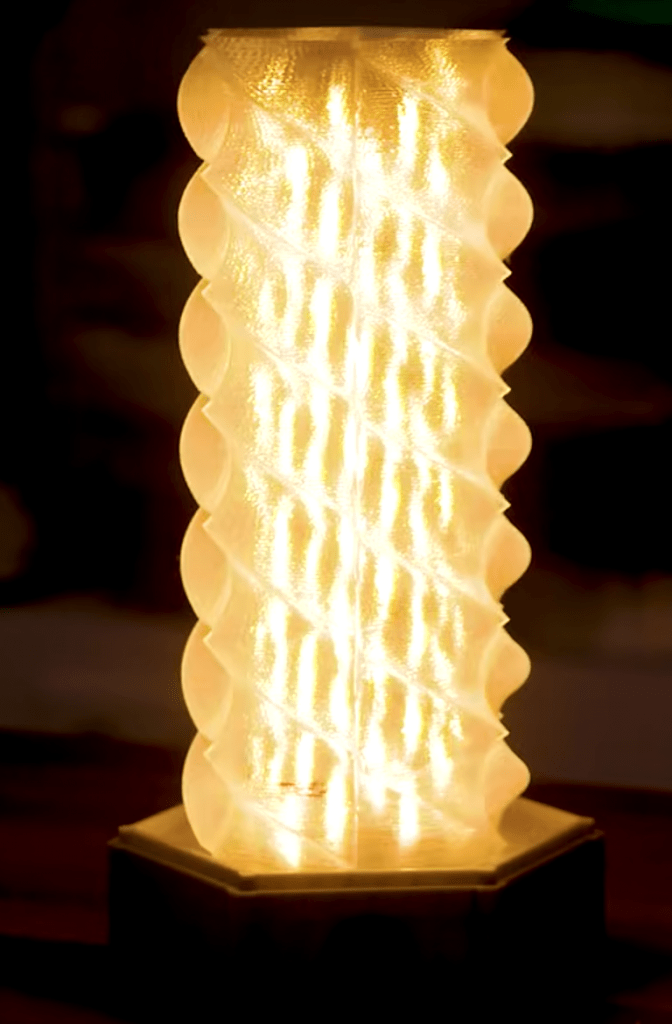
Naturally, you should use clear filament for any print you want to be transparent. Here are some suggestions for what to print with transparent materials:
- Window or Christmas ornaments
- Light covers and panels
- Display screens and covers
- Vases and decorations
- Phone covers
- Electronics cases
- Lampshades
With a sufficiently tough clear filament, you could also print engineering or machine components that allow the underlying structures to stay visible. It’s also a good choice for prototypes that show what’s inside the product casing.
Clearly Great Prints
3D printing with clear filaments lets you create unique-looking objects for a wide variety of purposes. Whether you want to make simple decorations or sturdy end-use components, the extensive range of translucent and transparent materials lets you print a clear part for any application. Your only challenge is picking the right material.
If you still need a little bit of help, here are our suggestions:
- Hatchbox PLA and ABS are your go-to filaments for transparent color prints.
- MSNJ Clear PMMA offers extremely clear transparency.
- SainSmart PRO-3 and Polymaker PolyLite PC print strong parts.
- Duramic Clear TPU lets you dip your toes into printing flexible parts.




